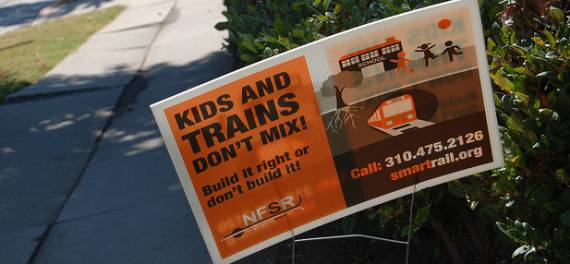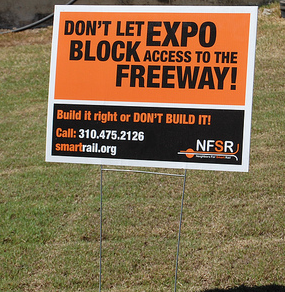(note: An earlier version of this story says that Robert Silverstein is representing Neighbors for Smart Rail. He has been replaced by John Bowman with a completely different law firm. Thanks to Dakota Smith at Curbed for the catch. To read more of Curbed's coverage of Expo, Phase II and this lawsuit, click here.)
Tomorrow morning, a group of Westside Homeowners calling themselves Neighbors for Smart Rail (NFSR) who have been fighting the at-grade plans for the Expo Line through their community will finally have their day in court. The group is arguing that the Final Environmental Impact Report certified by the Expo Construction Authority Board for Phase II of the Expo Line is faulty because, in their view, the documents didn't properly consider the California Environmenal Quality Act (CEQA) when deciding issues such as how to design the controversial grade crossings. When a decision is reached, even if Streetsblog is on its winter hiatus, we'll post the news as soon as we can.
Much like their allies in South L.A., NFSR has advocated for below-grade crossings for the Expo Line at major intersections. Much like in South L.A., the Expo Construction Authority deemed below-grade crossings too expensive and decided on different designs. Fair or not, the opposition to an at-grade Expo Line have been dogged that their complaints are more about keeping a train, and the less well-to-do people who ride it, away from their enclave. L.A. Weekly quotes former Cheviot Hills homeowners association president, Benjamin Cate, saying, "Do you think the people who live in Cheviot Hills are going to take this bloody train? No, they are going to get in their cars. The people who are going to use this are the people who work in the hotels in Santa Monica, and they are going to come from the Hispanic areas nearer downtown. Now they take the bus."
Proponents of the Expo Line like the agency's chances in court tomorrow. On Saturday, leaders of both Friends 4 Expo Transit and Light Rail for Cheviot expressed optimism that the case would be dismissed and the construction authority would move immediately towards construction.
The reason for the confidence? CEQA lawsuits are tough to win. At the end of the post you can read a full statement by Expo backer Gokhan Esirgen who goes in to detail on why this lawsuit is a hard sell. In short, an environmental review doesn't have to conclude that the an agency is choosing the best design for air quality, but merely that it is doing an adequate job mitigating impacts of project construction to meet the demands of CEQA. In other words, NFSR will have to show that the mitigation proposed by the Expo Construction Authority are deficient, not that just that they're inferior to grade-separated alternatives.
The other bad news for NFSR is that the judge hearing the case is Thomas McKnew who has a reputation for dismissing lawsuits challenging decisions of transit governance bodies. Most recently, he dismissed a Bus Riders Union lawsuit opposing Metro fare hikes in 2008.
For those that want to read more on the case, you can read all of the documents related to it by going to the Los Angeles Superior Court's Web site and type in the case number, BS125233. The trial is set to begin at 09:00 am in department H at 12720 Norwalk Blvd., Norwalk, CA 90650. The case is listed as a "short cause," meaning a decision on whether to allow the case to go forward towards a full trial or to dismiss the case could be decided before noon.
Esirgen's statement:
I think the Neighbors for Smart Rail (NFSR) case is almost certain to be dismissed on Tuesday, unless the judge discovers an unlikely mistake in the FEIR, which I don't believe exists.
The important thing to realize is that EIRs are not required to study everything, let alone be perfect. The main idea of CEQA is that for major projects like the Expo Line, environmental impacts and mitigations must be documented along with a reasonable range of alternatives that will reduce or mitigate these impacts.
The critical points are the "significant" impacts, and mitigations or alternatives must be studied to reduce the significant impacts. Once all the significant impacts are mitigated, the preparer of the EIR is not required to study in detail any other alternatives. (In the extreme scenario, if all mitigations and alternatives are studied but all are shown to be infeasible, this is recorded in the EIR and the project can still be built.) The main challenge of NFSR is that not enough alternatives (such as grade separation, other alignments, etc.) were studied. But Expo were able to mitigate all the significant impacts in the selected alternative (Expo right-of-way and Colorado Avenue with an at-grade section between Overland and Sepulveda); therefore, they were not required by CEQA to study in detail any further mitigations or alternatives. Yet, Expo did go ahead and analyzed the grade-separation options and found these to create significantly more construction and aesthetic impacts and be significantly more costly. In addition none of the NFSR's challenges to the EIR are specific and they make general challenges to most sections of the EIR.
In summary, under CEQA, a public agency can build anything it wants anywhere, as long as all the significant environmental impacts are mitigated. Alternatives (such as grade separation) need not be exhausted unless there are significant impacts remaining. If the reverse was the case, it would probably be impossible for a public agency to build anything. Opposition could always argue, for example, subways to be superior than light-rail or the transportation-systems management or no-build alternative to be superior to subways and hence put the scope of the project in an infinite loop.
After the dismissal of the case on Tuesday, the Phase 2 final design and construction will start in February. NFSR will have the option to appeal but given how weak their case is, it seems likely that they might not pursue additional funding from their homeowners' associations and supporters to cover the cost of such an appeal. In any case the design - build process won't wait for the results of an appeal.








